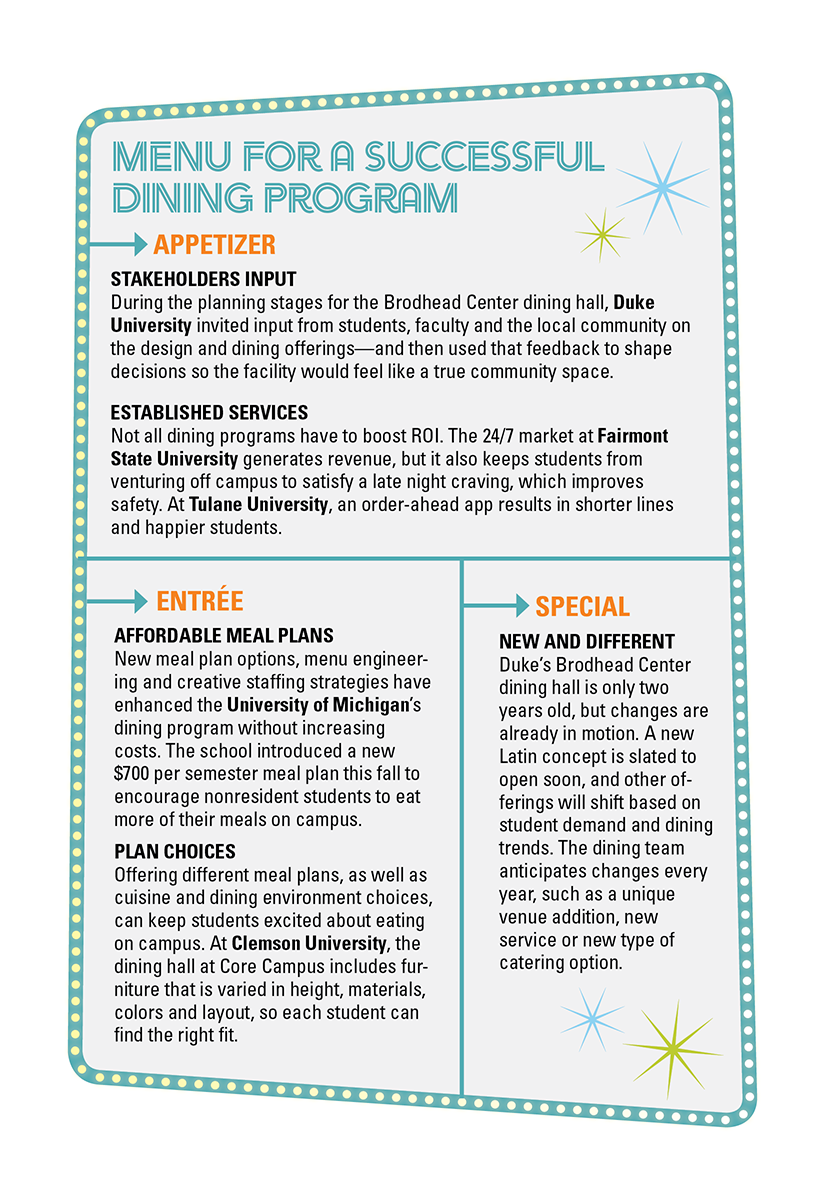With a never-ending supply of meal delivery and off-campus dining venues for students to choose from, many colleges struggle to keep campus dining halls busy—particularly during hours when classes aren’t in session. That’s in spite of the trend toward attractive campus dining hall features such as DIY cooking stations, vegetarian meal options, grab-and-go options and partnerships with popular national chain restaurants. Here are six so-called dining hall hacks to get students to spend more of their time in campus eateries.
1. Smart location choices
The age-old success strategy of placing the dining hall in the center of campus still rings true. But many colleges and universities are ensuring that residence halls, particularly new communities, include impressive dining facilities as well.
Residential dining keeps the food where students are all day and all night, plus offers opportunities to have the venue serve as a social hub.
One way colleges are getting location decision making right is by mapping where students spend the majority of their days and ensuring meal options are available in each of those areas. In other words, campus islands without food amenities are out of the question.
2. Variety in seating
Unlike at a traditional restaurant where turning around tables quickly is important, campus dining halls that encourage people to spread out with a laptop and sit for hours do well in drawing in business.
Make sofas and armchairs a facility necessity for students who need comfy spaces to write papers or visit with friends. Spaces should also accommodate groups working on projects, and booths or bar-height tables invite socializing over supper. In-season outdoor seating is another essential part of the mix.
3. Round-the-clock options
Even when keeping traditional dining halls open at all hours is not feasible, colleges are getting in on the 24-hour cashless market trend.
One example is University Terrace Marketplace at a Fairmont State University residential community in West Virginia.
Students can use debit or credit cards, flex dollars, or cash preloaded onto their dining cards to purchase deli items, salads, fruit and snacks. The market operates on the honor system. Students must scan their IDs to enter, and cameras are located over the door and self-checkout—eliminating the need for paid staff.
4. Food experiences
Some institutions are using pop-up dinners, or one-night-only menus, to create excitement over campus dining. Such events are generally covered by the meal plan.
One example is the vegan pop-up dinner organized by University of Michigan Dining in April 2018 at the East Quadrangle residence hall, where the community is passionate about sustainability and animal ethics. Five courses aimed to showcase the versatility and depth of flavor in vegetable-based menu presentations.
5. Flexibility in venue
 Out-of-the-box thinking on dining options to draw students in can mean anything from bringing local food trucks on campus to sharing a meal plan with a neighboring college or university.
Out-of-the-box thinking on dining options to draw students in can mean anything from bringing local food trucks on campus to sharing a meal plan with a neighboring college or university.
When Tulane University partnered with Loyola University New Orleans, its neighbor, have a long-standing partnership to offer shared venue options under the meal plan, students at each school won a lot more dining choices.
Venue flexibility also involves partnering with off-campus dining outlets so that the campus meal plan is accepted elsewhere. While this move may not generate a lot of revenue, students see more value in meal plans that include such opportunities.
And don’t forget convenience. Students sometimes want fast, easy to-go meals from traditional dining halls—and an ordering app is a good way to go about offering that service.
6. Successful dining program basics
Meeting student service expectations is also key to getting them to eat through campus dining.
This involves knowing what exactly they expect by requesting and applying student input.
Affordable meal plan options, including offerings geared toward nonresident students, is another piece of the successful program pie.
And finally, remember to continuously reinvent program offerings. Regardless of whether it’s a unique venue addition, a new service or a new type of catering, variety is the spice of life and a crucial component of a successful dining program.
Read the full original story on keeping students on campus for meals.
Melissa Ezarik is senior managing editor of UB.






